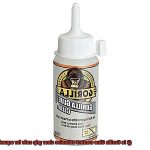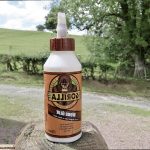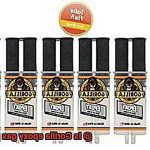Picture this: a mesmerizing underwater world filled with vibrant fish, swaying corals, and lush aquatic plants. But wait. Before you can immerse yourself in this aquatic wonderland, there’s one crucial thing you need – a leak-proof aquarium. And that’s where silicone sealants come into play.
Now, among the sea of options available, one name keeps popping up – Gorilla 100% Silicone Aquarium Sealant. It’s like the superhero of sealants, promising strength and durability. But here’s the million-dollar question: is it truly safe for your beloved fishy friends?
Well, worry not. In this blog post, we’re diving deep into the details of Gorilla’s silicone aquarium sealant. We’ll explore its benefits (because who doesn’t love a strong bond?), potential risks (cue dramatic music), and whether it deserves a spot in your tank maintenance arsenal.
So grab your snorkel and let’s explore together. By the end of this post, you’ll have all the information you need to make an informed decision about keeping your aquatic buddies safe and sound. Let’s get started.
What is Gorilla 100% Silicone?
Contents
- 1 What is Gorilla 100% Silicone?
- 2 Is Gorilla 100% Silicone Safe for Aquariums?
- 3 Benefits of Using Gorilla 100% Silicone in Aquariums
- 4 Preparation and Application of Gorilla 100% Silicone
- 5 Curing and Leak Testing the Seal
- 6 Potential Risks of Using Gorilla 100% Silicone in Aquariums
- 7 Alternatives to Using Gorilla 100% Silicone in Aquariums
- 8 Conclusion
Choosing the right adhesive for your aquarium is essential to ensuring its safety and longevity. Gorilla 100% Silicone is a high-quality sealant that offers unparalleled strength, durability, and versatility. In this article, we will explore the key features of Gorilla 100% Silicone and why it is the go-to choice for aquarium enthusiasts and professionals alike.
Key Features:
- 100% Silicone Formulation: Gorilla 100% Silicone is made entirely from silicone, guaranteeing a pure and high-quality adhesive that does not compromise on performance. Unlike other sealants that may contain additives or fillers, this silicone sealant delivers reliable results.
- Excellent Adhesion Properties: This sealant forms a strong bond with various materials commonly used in aquariums, such as glass, metal, plastic, and ceramic. Whether you need to repair leaks, bond glass panels, or seal joints, Gorilla 100% Silicone provides a secure and long-lasting seal.
- Resistance to Water and Moisture: Designed for applications involving constant exposure to water, Gorilla 100% Silicone creates a watertight seal that prevents leaks and ensures the safety of your aquatic pets. It is also resistant to mold and mildew growth, maintaining a clean and healthy aquarium environment.
- Versatility: Gorilla 100% Silicone is suitable for both indoor and outdoor use, making it a versatile choice beyond aquariums. From repairing window panes to sealing gaps in outdoor furniture, this adhesive delivers reliable results in various projects.
- Temperature Resistance: With an impressive temperature range of -40°F to 400°F (-40°C to 204°C), Gorilla 100% Silicone remains intact and performs optimally even in extreme conditions. It adapts well to both cold and hot environments.
Drawbacks:
While Gorilla 100% Silicone offers numerous benefits, proper application is crucial to achieving desired results. Consider the following:
- Curing Time: Allow sufficient time for Gorilla 100% Silicone to cure before introducing fish or water into the aquarium. Follow the manufacturer’s instructions and be patient to ensure a fully set sealant.
- Surface Preparation: Thoroughly clean and dry surfaces before bonding to optimize adhesion. Any debris or moisture left on the surface may hinder the effectiveness of the sealant.
Is Gorilla 100% Silicone Safe for Aquariums?
Aquarium enthusiasts understand the importance of a strong and reliable adhesive to ensure the safety of their aquatic habitats. One adhesive that often comes up in discussions is Gorilla 100% Silicone. But is it truly safe for your aquarium? Let’s take a closer look to find out.
Understanding the Debate:
The safety of using Gorilla 100% Silicone in aquariums is a topic that sparks debates among hobbyists. While this adhesive is marketed as waterproof and resistant to mold and mildew, it’s crucial to consider its suitability for aquatic environments.
The Importance of Safe Silicone:
Not all silicone sealants are created equal, and some may contain additives or chemicals that can harm aquatic life. When choosing a silicone sealant for your aquarium, you must look for specific labeling indicating its safety for aquarium use or adherence to industry standards such as ANSI/NSF Standard 51 for food contact.
The Gorilla 100% Silicone Dilemma:
Unfortunately, Gorilla 100% Silicone does not have specific labeling indicating its safety for aquariums. However, some aquarists have used it without any apparent issues. While this seems promising, caution should be exercised, and an informed decision should be made based on individual research and understanding of potential risks.
Expert Advice:
If unsure about the safety of using Gorilla 100% Silicone in your aquarium, consulting professionals or experienced aquarists with firsthand knowledge or expertise in this matter is advisable. Their guidance can provide valuable insights to help make an educated decision.
Prioritizing Aquatic Life:
Ultimately, the well-being and health of your aquatic life should be prioritized. While some hobbyists may endorse Gorilla 100% Silicone’s suitability for aquarium use, it is crucial to prioritize sealants that are explicitly labeled as safe for aquariums and meet industry standards. This ensures that no harmful substances will leach into the water and harm your beloved fish or plants.
Benefits of Using Gorilla 100% Silicone in Aquariums
Choosing the right adhesive is essential for maintaining a healthy and secure aquarium environment. In this article, we will explore the numerous benefits of using Gorilla 100% Silicone in aquariums. From its exceptional water resistance to its flexibility and ease of use, this reliable silicone offers a range of advantages that make it the preferred choice for sealing and bonding purposes.
Unmatched Water Resistance:
Gorilla 100% Silicone is specifically formulated for aquarium use, guaranteeing a robust and durable bond that can withstand constant exposure to water without deteriorating. This ensures that your tank’s seal remains intact, preventing leaks or damage that could harm your aquatic life.
Mold and Mildew Resistance:
Maintaining a clean and healthy environment for your fish is crucial. Gorilla 100% Silicone resists the growth of mold and mildew, effectively preventing the spread of harmful substances that could affect your fish and other organisms. This feature ensures the long-term well-being of your tank’s inhabitants.
Flexibility for Longevity:
Even after curing, Gorilla 100% Silicone retains its flexibility. This allows for natural movements and vibrations within the aquarium setup without compromising the integrity of the seal. With this flexibility, cracks or leaks are less likely to develop over time, providing added peace of mind.
Compatibility with Various Materials:
Whether your aquarium is made of glass, acrylic, or plastic, Gorilla 100% Silicone is safe for use with these materials. It adheres exceptionally well to different surfaces, creating a strong bond that guarantees the structural integrity of your tank.
Non-Toxic Composition:
The safety of your aquatic life is paramount, and Gorilla 100% Silicone ensures their well-being by being completely non-toxic. You can trust that this silicone does not release any harmful chemicals into the water, minimizing any potential risks to your fish and other organisms.
Reliable and Durable Seal:
Using Gorilla 100% Silicone in your aquarium provides a secure and long-lasting seal, significantly reducing the risk of leaks or damage to the tank. This reliability allows you to have peace of mind, knowing that your aquatic habitat is protected.
Excellent Adhesion Properties:
Gorilla 100% Silicone exhibits outstanding adhesion properties, making it the perfect choice for bonding rocks, ornaments, and equipment commonly found in aquarium setups. Its ability to bond well with various materials adds versatility to its applications within the tank.
Easy Application and Fast Curing:
Designed for convenience, Gorilla 100% Silicone is available in squeeze tubes or caulking gun cartridges, making it simple to apply and work with. Additionally, it has a fast curing time, allowing for quick and efficient sealing of the aquarium without prolonged waiting periods.
Preparation and Application of Gorilla 100% Silicone
In this guide, we will take you through the preparation and application process of this incredible product, ensuring a secure and watertight aquarium for your beloved fish and aquatic creatures.
Preparation is key to achieving a successful bond with Gorilla 100% Silicone. Just like a superhero needs a clean canvas to work their magic, this silicone requires a clean and smooth surface. Begin by giving your aquarium a thorough scrub using a non-toxic cleaner designed specifically for aquariums. Eliminate any dirt, dust, or debris that could interfere with the bonding process. Rinse the surface thoroughly and allow it to dry completely.
Now, let’s tackle those pesky traces of old silicone or adhesive. Armed with a scraper or razor blade, carefully remove any remnants left behind by previous sealants. We cannot stress enough how important it is to rid your aquarium of any old silicone. Its presence can lead to poor adhesion and compromise the integrity of your new seal.
Once your surface is clean and free from any old silicone, it’s time to unleash Gorilla 100% Silicone’s sidekick – the primer. This trusty companion enhances adhesion and creates a stronger bond. Follow the manufacturer’s instructions for applying the primer and allow it to dry according to the recommended time.
Now that we’re all prepped and ready for action, it’s time for the main event – application. Equip yourself with a caulking gun, gloves, and a damp cloth for that flawless finish. Load up a tube of Gorilla 100% Silicone into the caulking gun and cut off the tip at a 45-degree angle. With unwavering pressure on the trigger, apply a small bead of silicone along one edge of the glass or material you’re sealing. Move smoothly along the surface, ensuring the silicone covers the entire area in need of sealing.
With the application complete, it’s time to add a touch of finesse. Grab that damp cloth or sponge and gently smooth out the silicone, removing any excess. We must caution against excessive wiping or using excessive force. Allow the silicone to work its magic.
Now, exercise patience as you let the silicone cure. Follow the manufacturer’s instructions for the recommended curing time, bearing in mind that factors like temperature and humidity can influence it. Be vigilant during this period and resist the temptation to rush the process. Give the silicone the time it needs to fully cure.
After the silicone has achieved its superhero status, put your aquarium to the ultimate test. Rinse it thoroughly to eliminate any residue or loose particles. Fill up the tank with water and let it sit for a couple of days, ensuring there are no leaks or issues with the seal. Keep a watchful eye on your tank during this period, just in case any problems arise before introducing your aquatic friends.
![]()
Curing and Leak Testing the Seal
Get ready to unleash your inner superhero in the world of curing and leak testing the seal with Gorilla 100% silicone for aquariums. We’re diving deep into the exciting process of ensuring your underwater paradise is leak-free and ready for your aquatic buddies to thrive.
Curing the silicone is like watching it transform from a mere goo to a powerful force. It’s all about hardening and reaching its full strength. To achieve the best results, follow the manufacturer’s instructions for curing time. Gorilla 100% silicone typically requires at least 24 hours to cure fully, but for optimal results, give it 48-72 hours. During this time, keep your aquarium empty and avoid any disturbances that could mess with the bonding process. Your fish will thank you later when they’re swimming in a secure and watertight environment.
Once your silicone has had ample time to cure, it’s time for the thrilling leak test. Imagine yourself as a detective, on a mission to uncover any weak spots or gaps in the seal that need attention. Grab a clean bucket or hose with a gentle flow and carefully fill your tank with water. Watch closely for any signs of leakage as you fill up the tank. Don’t miss a beat as you check every nook and cranny where silicone has been applied—corners, joints, seams—every inch matters.
But wait, don’t get too comfortable just yet if the initial fill-up doesn’t reveal any leaks. Let the water sit in the tank for a few hours or even overnight. This extended period allows for better detection of those sneaky slow leaks that might occur over time. Keep an eagle eye out for any water accumulation or dampness around the seal. These are red flags signaling potential leakage that needs immediate attention.
Now, let’s say you spot a minor leak during the test. Don’t panic. Empty the tank and let it dry completely before attempting repairs. Once dry, inspect the affected area and assess the damage. If the leak is minor, you can save the day by applying an additional layer of Gorilla 100% silicone over the troubled spot. But remember, cleanliness is key. Make sure to clean the surface thoroughly before reapplying the silicone. Smooth it out with a silicone tool or your finger, creating a seamless seal that’s as smooth as a superhero landing. Then, give it enough curing time before conducting another leak test—no leaks should escape your watchful eye.
However, in cases where you encounter major leaks or extensive damage, it’s time for a heroic act. Remove and replace the entire silicone seal. It may require a bit more effort, but trust me, your fish will be forever grateful for your superhuman efforts in providing them with a watertight sanctuary.
Potential Risks of Using Gorilla 100% Silicone in Aquariums
Creating a stunning aquatic paradise for your underwater companions is an exciting endeavor. As you gather the necessary materials, including Gorilla 100% silicone, it’s crucial to recognize the potential risks that come with using this popular adhesive in aquariums.
Additives and Their Effects:
Although Gorilla claims their silicone is 100% pure, there may be additives lurking within the formula. These additives can seep into the water, wreaking havoc on your aquatic life. Some chemicals can be toxic, leading to health issues or even death for your fish, invertebrates, or plants.
Durability and Longevity:
While Gorilla 100% silicone may be suitable for certain applications, its endurance and longevity in an aquatic environment are dubious. The relentless pressure of water and temperature fluctuations can cause the silicone to deteriorate over time. This degradation can result in leaks or structural problems with your tank, potentially damaging your aquarium and endangering its inhabitants.
Improper Application:
Following the manufacturer’s instructions to the letter is essential when using Gorilla 100% silicone. Failure to apply it correctly or cure it thoroughly can lead to the release of harmful chemicals into the water or premature breakdown of the silicone itself. Both scenarios pose significant risks to your aquatic environment.
Compatibility Issues:
Gorilla 100% silicone may struggle to adhere adequately to certain materials commonly found in aquariums, such as glass or acrylic. Pairing incompatible materials compromises the tank’s integrity and jeopardizes the safety of your aquatic life.
Lack of Specific Formulation and Testing:
It’s crucial to note that Gorilla 100% silicone is not specifically formulated or tested for aquarium use. While it may excel in other industries, its suitability for aquariums remains uncertain. To minimize risks and ensure a secure environment for your underwater friends, opt for silicone sealants explicitly designed and labeled for aquarium use.
Alternatives to Using Gorilla 100% Silicone in Aquariums
Embarking on the journey of creating a thriving aquarium is an exhilarating experience, but selecting the right adhesive or sealant is paramount to ensure the safety and well-being of your aquatic companions. Although Gorilla 100% Silicone is a popular choice, there are several alternatives worth exploring. This article delves into various options, examining their suitability for different aquarium setups.
Epoxy-Based Adhesives:
Renowned for their strength and durability, epoxy adhesives are ideal for bonding glass panels in aquarium construction. These adhesives offer excellent resistance to water and chemicals, providing a secure and long-lasting seal that ensures the structural integrity of the aquarium.
Polyurethane-Based Sealants:
Polyurethane sealants are flexible, making them suitable for larger aquariums where slight shifts may occur due to water pressure. These sealants not only provide reliable bonding between glass panels but also maintain flexibility, preventing any compromise in the seal and ensuring a watertight environment.
Acrylic Adhesives:
Acrylic adhesives offer exceptional bonding strength and create a clear, transparent seal. However, it is important to assess whether they are suitable for your specific aquarium needs, as they may not be ideal for high-pressure tanks or those with larger dimensions.
Plant-Based Adhesives:
For eco-conscious aquarists seeking a more natural alternative, plant-based adhesives made from renewable resources can be considered. However, it is crucial to ensure that these adhesives do not contain any harmful additives or chemicals that could harm aquatic life.
Mechanical Methods:
In addition to using adhesives, mechanical methods such as brackets, clamps, or specialized panel connectors can provide additional structural support for aquariums. These methods reduce reliance on adhesives and offer peace of mind regarding the long-term integrity of the aquarium.
Conclusion:
When considering alternatives to Gorilla 100% Silicone for your aquarium, it is crucial to carefully evaluate your specific needs. Factors such as water pressure, tank size, and the type of aquatic life being housed should be taken into consideration. Consulting with experts or experienced aquarists can provide valuable insights and guidance in selecting the most appropriate alternative for your aquarium setup.
kepoUKNVSIw” >
Conclusion
In conclusion, Gorilla 100% silicone is indeed safe for aquarium use.
Its high-quality formulation ensures that it is non-toxic and will not harm your aquatic friends. With its strong adhesive properties, it creates a watertight seal that will withstand the test of time.
Whether you’re setting up a new aquarium or performing maintenance on an existing one, Gorilla 100% silicone provides peace of mind knowing that your beloved underwater ecosystem is secure.





